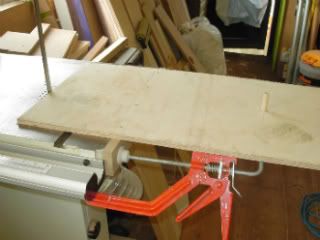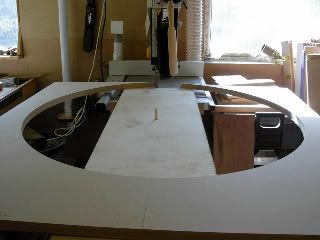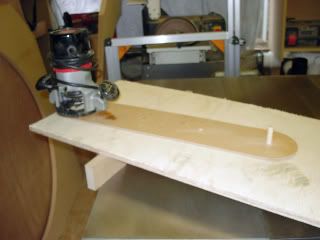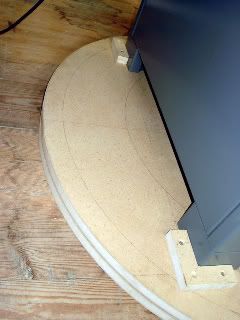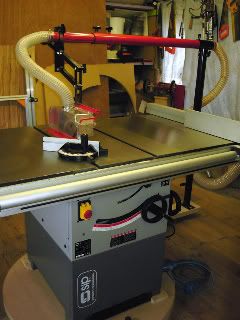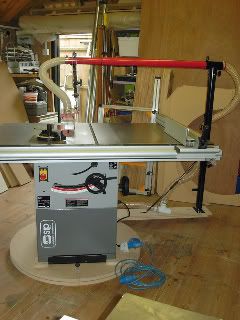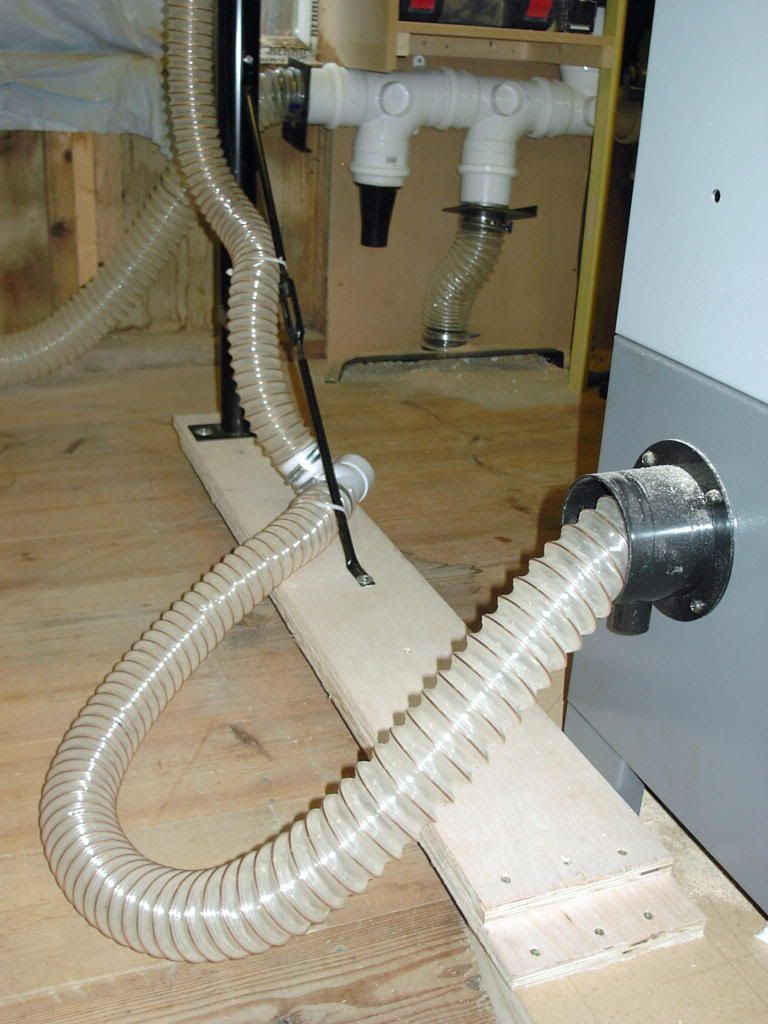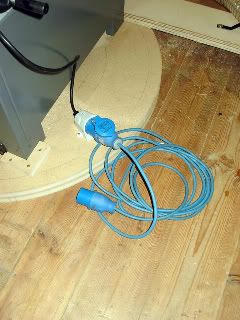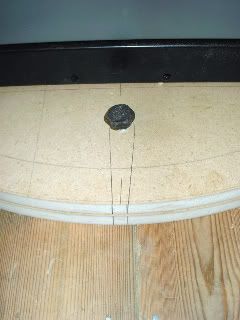I brought this thread forwards as it will help me in the construction of my other ongoing thread ( my new tool cabinet.)
I use a SIP 01332 table saw which does not have any cross-cutting facilities with it, which retails at about £360, I still had my old Triton ETA300 cross-cutting sliding table attachment, so though I would try to attach this to the end of the sip table to see how it worked out, nothing really to lose, I paid some two years earlier about £160 so if successful quiet a saving, as I knew this attachment is very accurate. ( if set up correctly).
My plans for the saw which I have been planning for some time now we're to have a sliding table and a router station fitted into it as well, another reason for purchasing extra extension beds.
 I have already fitted the extension bed leaves to the saw one on each side of the original tabletop my reasoning behind this is to be able to cut full sheets of material either way, on my own, without an extra pair of hands to help steady the sheet as it comes through the saw whilst being cut. I still have to build an outfeed table ( but that's another thread).
I have already fitted the extension bed leaves to the saw one on each side of the original tabletop my reasoning behind this is to be able to cut full sheets of material either way, on my own, without an extra pair of hands to help steady the sheet as it comes through the saw whilst being cut. I still have to build an outfeed table ( but that's another thread). As my table saw sitting on a turntable, I wanted it to be able to either have the sliding carriage removable or if I choose leave it attached to swivel around with the saw, this would depend on what other work was going on in the workshop at any given time.
As my table saw sitting on a turntable, I wanted it to be able to either have the sliding carriage removable or if I choose leave it attached to swivel around with the saw, this would depend on what other work was going on in the workshop at any given time.First I had to find a way of attaching it so it could be easily removed or reassembled with ease and very quickly. I decided to copy the way Triton attached it to there own work-centres. luckily I still had the brackets to do so.
If it was to at times remain attached but temporarily not use I needed it to fold down so I sourced some folding shelf brackets, very strong ones, but I am disappointed with the amount on slack in the design of these, they allow the shelve to dip just under 90 degrees when underweight, which I will now have to make allowances for as I design the rest of the project.
Now I needed to attach the second slide bar to the shelve so I use the same principle as Triton did on the first bar. I used flat steel bar 25mm * 5mm cut and bent it in the workshop vice with a small mortice and tenon cut into them. Then I had to think of a way of fixing them to the slide bar. As seen in the pic here to the right two centre pops already marked ready for drilling.
 I used this method of fixing to the bar two pop rivets and one thread countersunk bolt till I was satisfied I had both brackets set up correctly so that both bars were running spot on parallel with each other, to remove any sideways slack on the carriage guilds, so that each and every cut was cut square. Once I had this setup and correct I still had a very very minimum rocking movement on the bars, I can remove this once I take the bar to a welder this will remove all movement keeping the slides snugly fitted to the curve of the bars.
I used this method of fixing to the bar two pop rivets and one thread countersunk bolt till I was satisfied I had both brackets set up correctly so that both bars were running spot on parallel with each other, to remove any sideways slack on the carriage guilds, so that each and every cut was cut square. Once I had this setup and correct I still had a very very minimum rocking movement on the bars, I can remove this once I take the bar to a welder this will remove all movement keeping the slides snugly fitted to the curve of the bars.  Now that the two slide bars are fitted and secure, time to give thought to the sliding carriage itself. (shown here before reduced in length). I mentioned above I had previously added two extra extension beds, this now moves the sliding carriage further to the left, so the original measuring scale is no longer accurate. I decided to shorten the carriage down in length,
Now that the two slide bars are fitted and secure, time to give thought to the sliding carriage itself. (shown here before reduced in length). I mentioned above I had previously added two extra extension beds, this now moves the sliding carriage further to the left, so the original measuring scale is no longer accurate. I decided to shorten the carriage down in length,It's now a 702mm square which is its original width, I decided to board over the carriage and ignore the old built-in measurements.
 This was done with 6mm ply and stainless steel self-tapping screws, now it was time to make sure the ply top came level with the steel bed on the table saw this was easily adjusted on the two chrome brackets securing the slide bar as the top screw holes were elongated, with a slight adjustment this was soon achieved.
This was done with 6mm ply and stainless steel self-tapping screws, now it was time to make sure the ply top came level with the steel bed on the table saw this was easily adjusted on the two chrome brackets securing the slide bar as the top screw holes were elongated, with a slight adjustment this was soon achieved. 
The two slide bar are now parallel with each other and parallel with the saw blade as shown here. ( spot-on)
Now the fence itself, I wanted it to include a sliding stop, plus new self-adhesive measuring tape which was sourced from Axminster I used Kreg slide rail, self-adhesive tape, and a sliding stop.
The fence itself is 56mm * 19mm *1.830mm hardwood screwed and glued with a softwood backing board secure to the sliding carriage.

 The fence I kept short by 2mm from the edge of the blade, to stiffen the fence I used a 19mm * 100mm softwood and the Kreg slide bar once these were fitted the fence is now ridged with no flexing in its length.
The fence I kept short by 2mm from the edge of the blade, to stiffen the fence I used a 19mm * 100mm softwood and the Kreg slide bar once these were fitted the fence is now ridged with no flexing in its length.To cut in the cross-cut position, I can cut just a little over 605mm in width.
To cut across a full sheet simply pick up the slide carriage and turn the whole thing 180 degrees replace it on the slide rails and push till it reaches the stops on the far end, this will give you a ripping depth of just under 1300mm.

I sourced two toggles hold downs from Axminster yesterday afternoon shown here screwed down with heavy gauge self tappers.
Here is shown the completed fence with the second self-adhesive measuring tap attached to use when in panel ripping mode. and also showing attached to the face of the fence self-adhesive sandpaper to add some extra grip to larger panels when cutting, for this I simply used self-adhesive round sanding disc and cut them in 45mm strips.

The completed sliding carriage and fence with one coat of sanding sealer still drying.


ADDITIONAL WORK
additional work I added to the table saw and OUT FEED TABLE I added this to help stop the ply section to the right of the saw blade from tipping when I cut an 8 * 4 ft sheet in half, lengthways, When the cut is fully cut at that point, the left section was fully supported by the sliding carriage, To the right of the blade there was more of the sheet overhanging the back of the table saw bed than was actually still on the saw table bed, this I found to be very dangerous.

 The outfeed table its also of fold-down design using the same type of brackets I used on the cross cuttable.
The outfeed table its also of fold-down design using the same type of brackets I used on the cross cuttable.I can now crosscut a full sheet, with 50" to the right of the blade, to the left infinity.
I can cut up to 630mm cross cut in front of the blade.
Sliding Carriage LEG MODIFICATION.
On the Triton eta300 sliding carriage the legs are detachable but in one continues length shown here with the folding foot, I decided mainly as my table saw the site on a turntable, when I want to turn the table with these legs attached they had to be removed first then set up again,(time-consuming), these legs are necessary to stop any flexing in the length of the slide bars when in the rip mod as the weight of the sheet transfers past the back edge of the saw table.
To be able to do this I needed to redesign the legs to remain attached at all times, I used the same design shown here. When in the cross-cut model, when cutting narrow timber or sheet material then the legs don't need to be folded down for extra support.
It's so simple I'll let the picture speak for themselves.



Over head Storage .
ENJOY.































